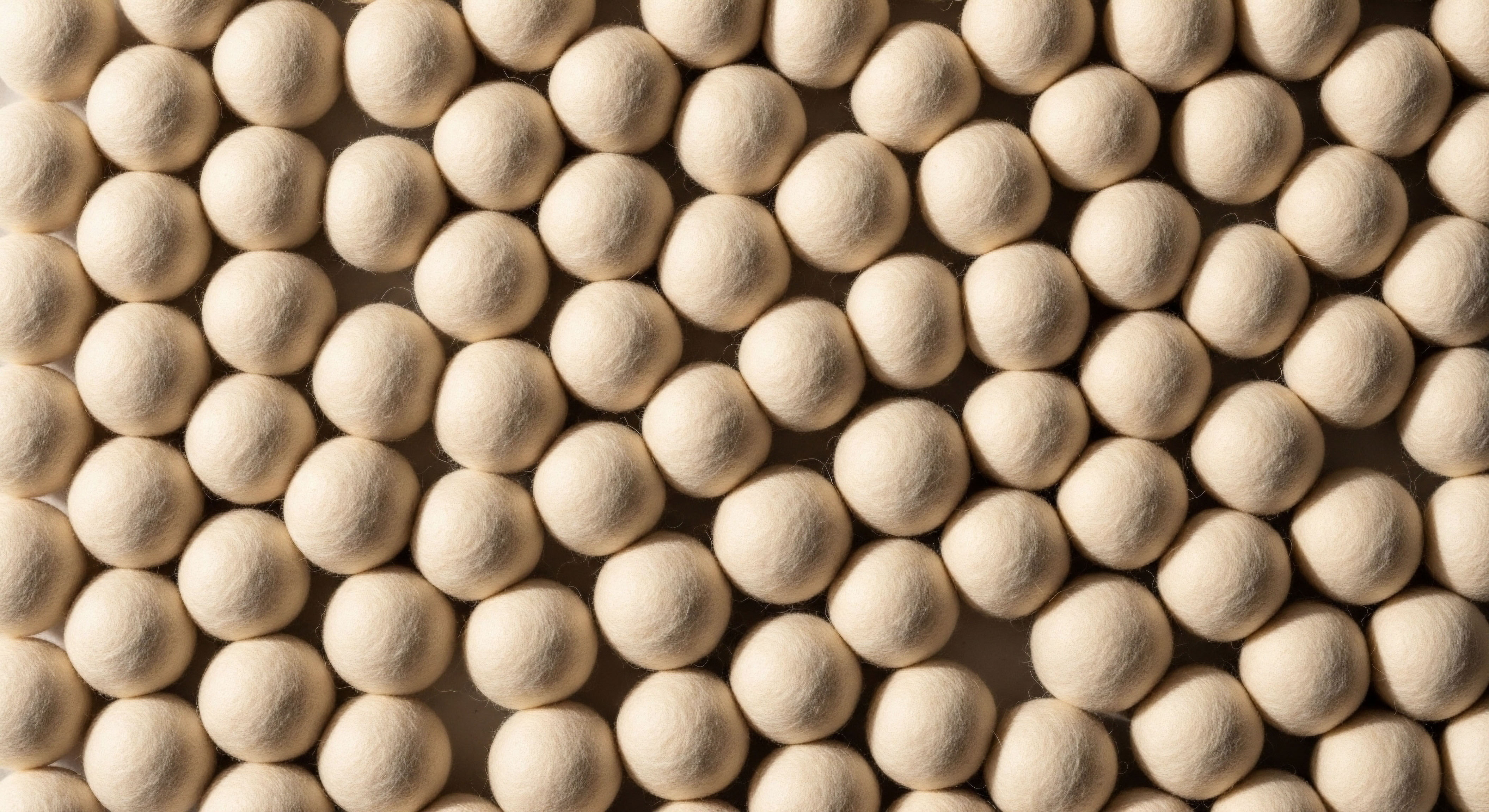

Fundamentals
You feel it before you can name it. A subtle shift in energy, a quiet dimming of vitality, a sense that the person you know yourself to be is becoming harder to access. The fatigue settles deep in your bones, the mental fog clouds your focus, and the physical resilience you once took for granted seems to be waning.
When a blood test confirms low testosterone and you begin a protocol of hormonal optimization, there is a sense of relief. A diagnosis provides a name for the struggle, and a treatment plan offers a path forward. Yet, the journey of reclaiming your well-being is a collaborative process between the therapeutic intervention and the biological system it is designed to support.
The question of how to enhance the efficacy of Testosterone Replacement Therapy (TRT) is central to this journey. The answer lies in understanding that the therapy itself is a key, but the lifestyle you build around it determines how smoothly that key turns the lock.
To grasp this concept, we must first look at the body’s internal communication network ∞ the endocrine system. This intricate web of glands and hormones functions like a sophisticated messaging service, sending chemical signals that regulate everything from metabolism and mood to sleep cycles and sexual function.
At the heart of male hormonal health is the Hypothalamic-Pituitary-Gonadal (HPG) axis. This is a three-way conversation ∞ the hypothalamus in the brain sends a signal (Gonadotropin-Releasing Hormone, or GnRH) to the pituitary gland. The pituitary, in turn, releases Luteinizing Hormone (LH) and Follicle-Stimulating Hormone (FSH) into the bloodstream.
LH is the specific messenger that travels to the testes, instructing them to produce testosterone. When external testosterone is introduced through TRT, the body’s natural production is often downregulated because the brain perceives that enough testosterone is present. This is a normal feedback loop. However, the administered testosterone still needs to navigate the complexities of your unique physiology to be effective.
Your body’s hormonal environment is not a passive recipient of therapy; it is an active participant that can either amplify or dampen the intended effects.

What Is Testosterone’s Role in the Body?
Testosterone is a primary androgenic hormone, and its influence extends far beyond libido and muscle mass. It is a fundamental regulator of systemic health. Its presence and proper function are critical for maintaining a vast array of physiological processes. Acknowledging its widespread impact is the first step in understanding why a holistic approach to TRT is so effective. The hormone interacts with receptors in cells throughout the body, influencing systems in ways that are both direct and indirect.
Consider its diverse functions:
- Musculoskeletal Health ∞ Testosterone directly stimulates muscle protein synthesis, which is the process of building and repairing muscle fibers. It also plays a vital part in maintaining bone mineral density, signaling the body to strengthen the skeletal framework and reduce the risk of fractures.
- Metabolic Function ∞ This hormone is a key player in metabolic regulation. It helps modulate insulin sensitivity, making it easier for your cells to use glucose for energy. It also influences fat distribution, with healthy levels promoting lean body mass and discouraging the accumulation of visceral fat, the metabolically active fat stored around the organs.
- Cognitive and Mood Regulation ∞ The brain is rich with androgen receptors. Testosterone influences neurotransmitter systems that affect mood, motivation, cognitive clarity, and spatial reasoning. Symptoms like brain fog, low drive, and depressive feelings are often linked to deficiencies in this signaling.
- Red Blood Cell Production ∞ Testosterone stimulates the production of erythropoietin (EPO) in the kidneys, a hormone that signals the bone marrow to create new red blood cells. This process is essential for maintaining healthy oxygen-carrying capacity in the blood, which directly impacts energy levels and stamina.
When you begin TRT, you are reintroducing this powerful signaling molecule into your system. The goal is to restore these functions. However, the environment into which it is introduced ∞ an environment shaped by your diet, exercise, sleep, and stress levels ∞ will dictate how efficiently it can perform its duties. Lifestyle adjustments are the tools you use to prepare the terrain, ensuring the seeds of therapy can fully grow.


Intermediate
Optimizing Testosterone Replacement Therapy requires a shift in perspective. The treatment is not a standalone solution but a powerful catalyst within a larger biological system. Its success is contingent upon the health of that system. Lifestyle adjustments, therefore, are not merely supportive habits; they are direct modulators of hormonal signaling, metabolic efficiency, and cellular health.
By strategically managing nutrition, exercise, sleep, and stress, you can create a physiological environment where administered testosterone can function with maximum impact, leading to superior clinical outcomes and a more profound sense of well-being. This is the process of moving from passive recipient to active collaborator in your own health restoration.

How Does Nutrition Architect the Hormonal Milieu?
The food you consume provides the raw materials for every biological process, including hormone synthesis and transport. A well-formulated nutritional strategy can directly enhance TRT efficacy by managing two critical factors ∞ Sex Hormone-Binding Globulin (SHBG) and inflammation. SHBG is a protein that binds to testosterone in the bloodstream, rendering it inactive.
While some binding is necessary, excessively high SHBG levels can mean that even with adequate total testosterone from TRT, the amount of “free” testosterone available to your cells is insufficient. High insulin levels, often driven by diets high in refined carbohydrates and sugars, can increase SHBG. Conversely, a diet that stabilizes blood sugar and improves insulin sensitivity can help lower SHBG, freeing up more testosterone to do its job.
Furthermore, chronic low-grade inflammation, often stemming from a diet high in processed foods and unhealthy fats, creates systemic “noise” that interferes with hormonal signaling. Adipose tissue, particularly visceral fat, is a primary source of this inflammation and also a site of aromatase activity ∞ the enzyme that converts testosterone into estrogen. A nutrient-dense, anti-inflammatory diet helps to reduce this enzymatic conversion, preserving the testosterone administered via TRT for its intended purpose.
| Nutritional Component | Mechanism of Action | Primary Food Sources |
|---|---|---|
| Lean Protein | Provides essential amino acids for muscle protein synthesis, which is amplified by TRT. Supports satiety and stable blood glucose. | Chicken breast, turkey, fish, lean beef, eggs, legumes. |
| Healthy Fats | Crucial for the structure of cell membranes, allowing for efficient hormone receptor function. Monounsaturated and omega-3 fats have anti-inflammatory properties. | Avocado, olive oil, nuts, seeds, fatty fish (salmon, mackerel). |
| Complex Carbohydrates | Provide sustained energy and fiber, which helps regulate insulin response and lower SHBG. Supports gut health, which is linked to systemic inflammation. | Oats, quinoa, brown rice, sweet potatoes, vegetables. |
| Micronutrients (Zinc & Vitamin D) | Zinc is a cofactor in testosterone production pathways. Vitamin D functions as a hormone and is correlated with healthy testosterone levels. | Zinc ∞ Oysters, beef, pumpkin seeds. Vitamin D ∞ Sunlight exposure, fatty fish, fortified foods. |

Exercise as a Potentiator of Testosterone Signaling
Physical activity is a powerful physiological stimulus that works in synergy with TRT. Exercise does not just burn calories; it sends potent signals to your muscles, metabolism, and endocrine system that enhance the body’s ability to use testosterone effectively. The two most impactful modalities are resistance training and high-intensity interval training (HIIT).
Strategic exercise reshapes the body’s metabolic machinery, making it more receptive and efficient in utilizing the testosterone provided by therapy.
Resistance training, such as lifting weights, directly stimulates muscle fibers. This action increases the density of androgen receptors within the muscle cells. With more receptors available, the testosterone circulating from your TRT has more places to bind and initiate muscle protein synthesis.
This leads to more significant improvements in lean muscle mass and strength than TRT alone could provide. HIIT, on the other hand, is exceptionally effective at improving insulin sensitivity. By depleting muscle glycogen stores and challenging the cardiovascular system, HIIT forces the body to become more efficient at managing blood sugar. As discussed, improved insulin sensitivity helps to lower SHBG, thereby increasing free testosterone. This metabolic enhancement ensures that the testosterone you are administering is maximally bioavailable.

The Foundational Roles of Sleep and Stress Management
The efficacy of TRT can be profoundly undermined by inadequate sleep and chronic stress. These two factors govern the body’s master regulatory systems, and their disruption creates a hormonal environment that is counterproductive to the goals of therapy. Sleep is when the body undergoes critical repair and hormonal regulation.
The majority of natural testosterone release is tied to deep sleep cycles. While TRT provides an external source of the hormone, poor sleep still disrupts the broader endocrine cascade, including growth hormone release and cortisol regulation. Sleep deprivation is a potent physiological stressor that elevates cortisol, the body’s primary stress hormone.
Chronic stress, whether from lack of sleep, work pressures, or emotional strain, leads to persistently elevated cortisol levels. Cortisol has a catabolic effect, meaning it breaks down tissue, and it directly antagonizes the anabolic, or tissue-building, effects of testosterone. It can increase SHBG and promote the storage of visceral fat, which, as we know, increases aromatase activity.
Therefore, managing stress through practices like meditation, deep breathing, or mindfulness is not a “soft” recommendation; it is a hard-line physiological necessity for ensuring the success of your hormonal optimization protocol. These practices help to lower cortisol, allowing testosterone to exert its beneficial effects without opposition.


Academic
A sophisticated understanding of Testosterone Replacement Therapy efficacy moves beyond simple metrics of serum testosterone levels and into the complex interplay of endocrinology, immunology, and metabolic science. The ultimate determinant of TRT success is the cellular and systemic environment in which the exogenous hormone must function.
A dominant factor governing this environment is the persistent, low-grade inflammation associated with metabolic dysfunction, particularly that which originates from visceral adipose tissue (VAT). This tissue is not a passive storage depot for energy; it is a highly active endocrine and paracrine organ.
The “obesity-inflammation-aromatase” axis represents a critical feedback loop that can directly antagonize the therapeutic goals of TRT. Therefore, lifestyle adjustments, particularly those targeting diet and exercise, are best understood as targeted interventions designed to dismantle this hostile metabolic framework, thereby permitting optimal testosterone signaling.

The Pathophysiology of Visceral Adipose Tissue as an Endocrine Disruptor
Visceral adipose tissue, the fat surrounding the abdominal organs, is metabolically distinct from subcutaneous fat. In states of excess, particularly driven by poor diet and a sedentary lifestyle, VAT becomes dysfunctional. Adipocytes (fat cells) become hypertrophic and hypoxic, leading to cellular stress and death.
This state triggers an immune response, characterized by the infiltration of macrophages and other immune cells into the adipose tissue. These activated macrophages, along with the adipocytes themselves, begin to secrete a cascade of pro-inflammatory cytokines, such as Tumor Necrosis Factor-alpha (TNF-α), Interleukin-6 (IL-6), and Interleukin-1 (IL-1). This creates a state of chronic, systemic inflammation that has profound consequences for hormonal health.
This inflammatory environment directly promotes the expression and activity of the enzyme aromatase (CYP19A1) within the adipose tissue itself. Pro-inflammatory cytokines, particularly IL-6 and TNF-α, have been shown to upregulate the transcription of the aromatase gene. This creates a vicious cycle ∞ excess VAT generates inflammation, which in turn increases aromatase activity.
The increased aromatase then converts a greater portion of testosterone ∞ both endogenous and that supplied by TRT ∞ into estradiol. The resulting elevation in estrogen and reduction in the testosterone-to-estrogen ratio further promotes the deposition of visceral fat, perpetuating the cycle. This mechanism explains why some individuals on TRT may struggle to achieve desired outcomes in body composition and well-being without addressing underlying metabolic health. The therapy is, in effect, fighting against a powerful, self-sustaining biochemical headwind.
The inflammatory state induced by visceral adiposity functions as a metabolic antagonist to TRT, actively converting testosterone to estrogen and blunting its systemic effects.

How Do Lifestyle Interventions Disrupt the Inflammatory Cycle?
Lifestyle interventions are powerful tools for breaking this cycle at a molecular level. A diet low in processed foods and rich in anti-inflammatory compounds (like omega-3 fatty acids and polyphenols) reduces the substrate for inflammation. Caloric restriction and weight loss, specifically the reduction of VAT, is the most direct way to decrease the source of inflammatory cytokines and aromatase activity.
Studies have shown that weight loss predictably and linearly improves testosterone levels, in large part by dismantling this inflammatory, estrogen-producing machinery.
Exercise exerts its own potent anti-inflammatory effects. Muscle contraction releases myokines, such as Interleukin-10 (IL-10), which have systemic anti-inflammatory properties that directly counteract the pro-inflammatory cytokines produced by VAT. Furthermore, both resistance training and HIIT improve insulin sensitivity. Insulin resistance is tightly linked to visceral adiposity and inflammation.
By improving how the body handles glucose, exercise reduces the lipogenic (fat-storing) signals that contribute to VAT accumulation. This reduction in VAT decreases the overall inflammatory load and the total capacity for aromatization, allowing the administered testosterone from TRT to maintain its chemical identity and perform its intended anabolic and androgenic functions.
| Intervention | Target Pathway | Molecular Outcome | Impact on TRT Efficacy |
|---|---|---|---|
| Dietary Modification (Reduced refined carbs, increased fiber/healthy fats) | Insulin Signaling & Systemic Inflammation | Decreased insulin resistance, lower circulating pro-inflammatory cytokines (TNF-α, IL-6). | Reduces SHBG, decreases aromatase upregulation, improves testosterone bioavailability. |
| Resistance Training | Muscle Androgen Receptor Density & Myokine Release | Increased number of androgen receptors in muscle tissue; release of anti-inflammatory myokines. | Enhances testosterone’s anabolic effect on muscle and counteracts systemic inflammation. |
| High-Intensity Interval Training (HIIT) | Mitochondrial Biogenesis & Insulin Sensitivity | Improved glucose uptake and utilization, reduced visceral adipose tissue. | Lowers SHBG, significantly reduces the primary site of inflammation and aromatase activity. |
| Stress Reduction & Adequate Sleep | Hypothalamic-Pituitary-Adrenal (HPA) Axis | Lowered chronic cortisol levels. | Reduces cortisol’s catabolic opposition to testosterone and its effect on promoting visceral fat storage. |

What Is the Clinical Significance for Patient Management?
The clinical implication of this systems-biology perspective is clear ∞ TRT should not be prescribed in a vacuum. For patients presenting with hypogonadism, especially in the context of obesity or metabolic syndrome, a concurrent and aggressive lifestyle modification plan is a medical necessity for achieving optimal outcomes.
Relying solely on dose escalation of testosterone to overcome the metabolic headwinds of inflammation and aromatization is an inefficient strategy and may increase the risk of side effects related to elevated estrogen and hematocrit. The American Urological Association guidelines acknowledge that lifestyle modifications have the potential to increase testosterone levels and reduce symptoms.
The most effective clinical protocols will therefore integrate TRT with structured nutritional counseling and personalized exercise prescriptions. Monitoring patient progress should include not just serum testosterone levels, but also markers of inflammation (like C-reactive protein), metabolic health (like HbA1c and lipid panels), and body composition. This integrated approach reframes the treatment goal from merely normalizing a number to restoring the systemic health of the individual.

References
- Wittert, Gary. “The relationship between sleep disorders and testosterone in men.” Asian Journal of Andrology, vol. 16, no. 2, 2014, pp. 262-265.
- “Research Progress on the Relationship between Obesity-Inflammation-Aromatase Axis and Male Infertility.” Journal of Immunology Research, vol. 2021, 2021.
- Cohen, P. G. “Aromatase, adiposity, aging and disease. The hypogonadal-metabolic-atherogenic-disease and aging connection.” Medical Hypotheses, vol. 56, no. 6, 2001, pp. 702-8.
- “Dose-Response Effects of Exercise and Testosterone Replacement Therapy on Body Composition, Lean Mass, and Heart Rate Responses ∞ A Case Report Using Wearable Technology.” Journal of Functional Morphology and Kinesiology, vol. 9, no. 4, 2024.
- “Lifestyle Factors that can Support Testosterone Replacement Therapy (TRT) – Klinic.” Klinic, 14 Mar. 2025.
- Bhasin, S. et al. “Testosterone Therapy in Men with Hypogonadism ∞ An Endocrine Society Clinical Practice Guideline.” The Journal of Clinical Endocrinology & Metabolism, vol. 103, no. 5, 2018, pp. 1715-1744.
- “Abstract 5452 ∞ High-fat diet induces inflammation by increasing estrogen levels through Stat3, estrogen receptor alpha and aromatase in the mouse prostate.” Cancer Research, vol. 73, no. 8 Supplement, 2013.
- “Testosterone inhibits expression of lipogenic genes in visceral fat by an estrogen-dependent mechanism.” American Journal of Physiology-Endocrinology and Metabolism, vol. 311, no. 5, 2016.
- “Evaluation and Management of Testosterone Deficiency ∞ AUA Guideline.” American Urological Association, 2018.
- “Enhancing TRT ∞ Essential Lifestyle Changes for Optimal Results – TRT Nation.” TRT Nation, 22 Oct. 2024.

Reflection

Calibrating Your Internal Environment
The information presented here offers a map of the intricate biological landscape that governs your health. It details the pathways, explains the mechanisms, and outlines the strategies that can transform your experience with hormonal optimization therapy. This knowledge is a powerful tool, shifting your role from a passive patient to an informed architect of your own physiology.
The science validates what you may have intuitively sensed ∞ that how you live, eat, move, and rest has a profound impact on how you feel.
The journey to reclaim vitality is deeply personal. The data and protocols provide the framework, but your lived experience provides the context. Consider the areas in your own life where friction may exist. Reflect on the quality of your sleep, the nature of your diet, the consistency of your physical activity, and the presence of underlying stress.
Seeing these elements through the lens of hormonal health can be illuminating. They are not separate domains of “healthy living” but are, in fact, direct inputs into the very system your therapy is designed to support. The path forward involves a partnership ∞ a collaboration between you, your clinical team, and the powerful biological intelligence of your own body. The ultimate goal is to create an internal environment where health is not just restored, but can truly flourish.



